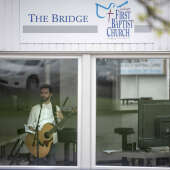There's enough water for Water Street
Q: There has been a lot of discussion about the direction that downtown traffic should run, but there are more urgent questions that should be asked about the basic infrastructure there. For example, how's the downtown firefighting water supply along Water Street and other downtown thoroughfares? Is there enough volume and pressure to even power sprinklers in more than one building at a time? If these are deficient, what's being done about it?
A: "One of several key benefits in undertaking the Water Street project was to install a 12-inch water main," said Kevin Priester, water resource manager with Alliance, the company which operates and maintains the city's water supply. "Before it was installed, the lines on Broadway and Themis were dead-end lines. These lines are now tied into the new 12-inch on Water Street. By doing so, they strengthen each other's ability to supply the area. There is very good pressure in the downtown area (low point) about 90 pounds per square inch. Engineering is in progress to extend the new 12-inch to both the north (tie into the 12-inch at Main and Mill streets) and to the south (tie into the 12-inch on William Street) and continue to the River Campus.
"So to answer your question, yes, there is more than adequate flow and pressure to run sprinkler systems and it will be excellent by the time the project is completed."
City fire chief Rick Ennis provided additional information about sprinkler systems.
"An automatic sprinkler system does not place a great demand on the water supply system," said Ennis. "Contrary to popular belief, fed by movies and television, when an automatic sprinkler system is activated, all of the sprinkler heads DO NOT flow water simultaneously, thus flooding the building. Each individual sprinkler head is activated independently by the heat of the fire.
"A common sprinkler head is designed to flow 12 to 18 gallons of water per minute. Statistics from the National Fire Protection Association indicate that 90 percent of the fires occurring in buildings equipped with automatic sprinkler systems are controlled by one or two sprinkler heads. That would mean a fire flow of less than 36 gallons of water per minute. In comparison, one single fire hose discharges 150 to 250 gallons of water per minute.
"If a fire were to occur in a downtown building equipped with an automatic sprinkler system, the fire would most likely be controlled in the matter of moments when the fire is still in its minor stage, barely causing a bleep on the water plant's computerized monitoring system," said Ennis. "In contrast, a fire occurring in a downtown building not equipped with an automatic sprinkler system would probably grow quickly and begin to spread. This would result in the fire department laying out multiple large-volume hose lines, creating a greater demand on the water main system, perhaps causing additional pumps to be turned on to meet that need."
Thanks, gentlemen, for your answers. Meanwhile, to readers of this column, perhaps it's the summer heat, but questions are barely dribbling in. If there's an interesting question on your mind, don't hesitate to send it my way!
Jon K. Rust is publisher of the Southeast Missourian. If you have a question, e-mail factorfiction@semissourian.com or call Speak Out (334-5111) and identify your call as a question for "Fact or fiction?"































Respond to this story
Posting a comment requires a subscription.